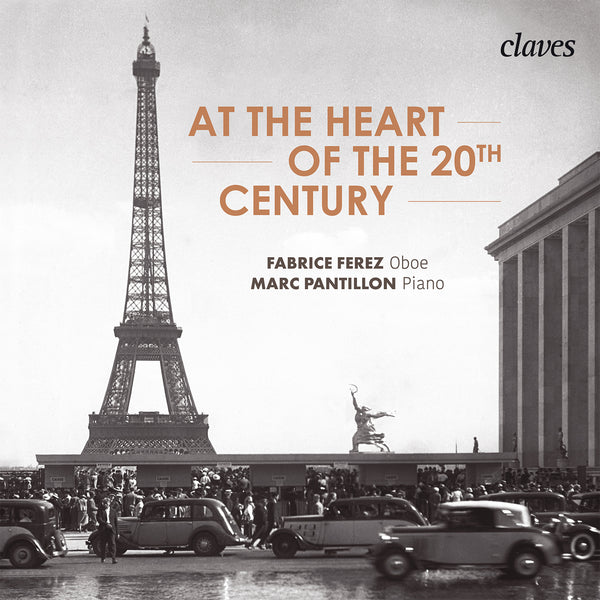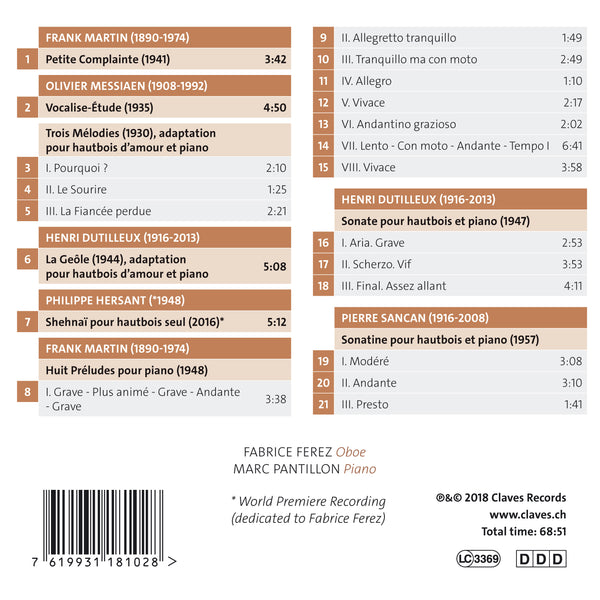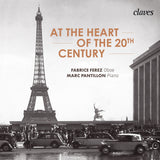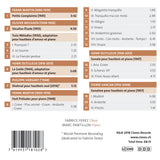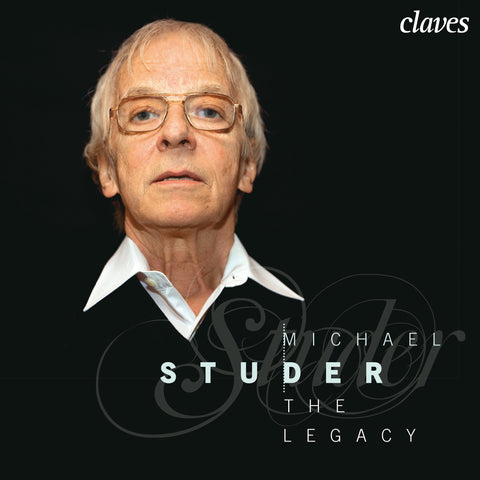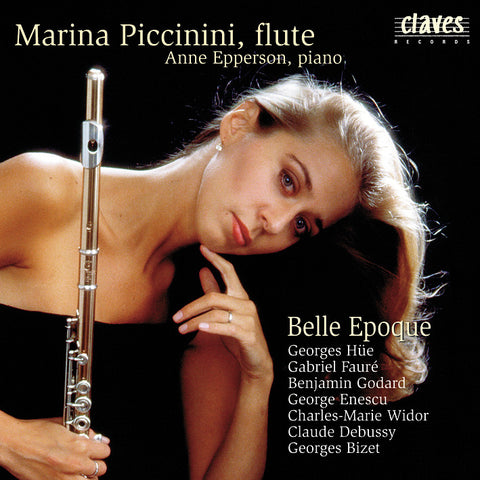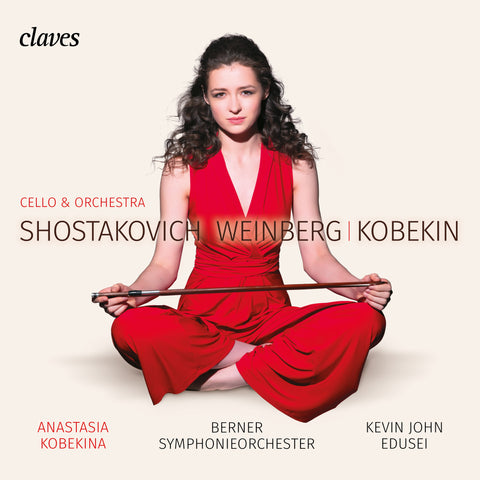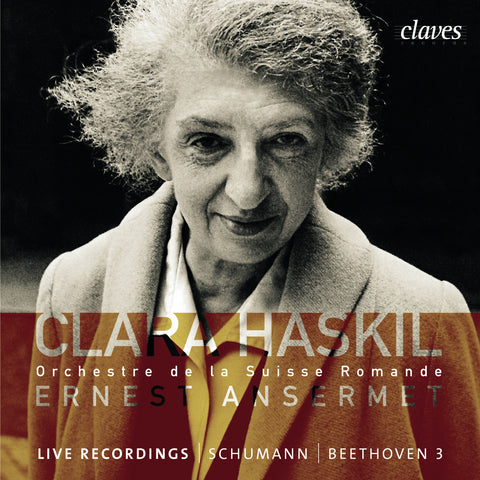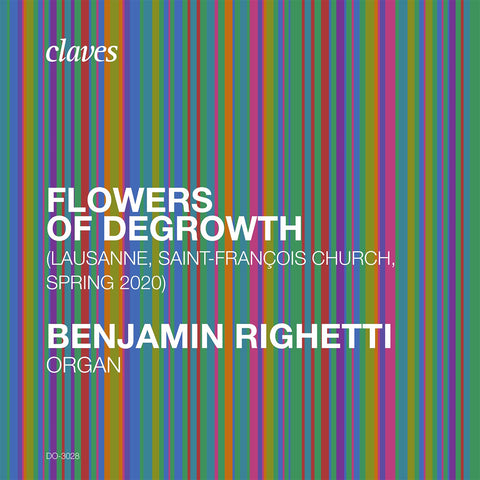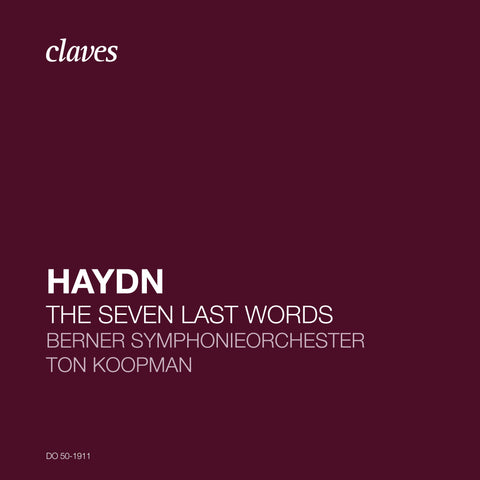(2018) AT THE HEART OF THE 20th CENTURY
Catégorie(s): Musique de Chambre Moderne Piano
Instrument(s): Hautbois Piano
Compositeur principal: Frank Martin
Nb CD(s): 1
N° de catalogue:
CD 1810
Sortie: 20.04.2018
EAN/UPC: 7619931181028
Cet album est en repressage. Précommandez-le dès maintenant à un prix spécial.
CHF 18.50
Cet album n'est plus disponible en CD.
Cet album n'est pas encore sorti. Précommandez-le dès maintenant.
CHF 18.50
Cet album n'est plus disponible en CD.
Cet album n'est plus disponible en CD.
TVA incluse pour la Suisse et l'UE
Frais de port offerts
Cet album est en repressage. Précommandez-le dès maintenant à un prix spécial.
CHF 18.50
Cet album n'est plus disponible en CD.
This album has not been released yet.
Pre-order it at a special price now.
CHF 18.50
Cet album n'est plus disponible en CD.
Cet album n'est plus disponible en CD.
AT THE HEART OF THE 20TH CENTURY
“…There is in each of us an interior mirror into which we dare not glance …”
Cécile Sauvage
Before and after the War
The works recorded here, with the obvious exception of Philippe Hersant’s solo, were written between 1930 and 1956. Following the CD that Marc and I had dedicated to the memory of the Jewish composer Pavel Haas, murdered by the Nazis, we wanted to delve further into this moment of History and tackle French and Swiss composers who had, naturally, been spared, but who were implicated in this most particular of periods.
Olivier Messiaen, upon his return from Stalag, was appointed professor at the Paris Conservatoire in 1942. Henri Dutilleux was then composing his first works marked by his brother’s captivity and the poetry of the resistant Jean Cassou, alias Jean Noir.
Pierre Sancan won the Rome Prize in 1943 and Frank Martin, who had just signed up with the prestigious Viennese Universal editions in 1940, produced some of his major works during this same period, of which Cinderella (Le Conte de Cendrillon) in 1941. In 1943 in Geneva, he also met the wonderful Romanian pianist Dinu Lipatti who was to become a faithful friend and the dedicatee of his Eight Preludes.
Oboe and nostalgia
According to Yvonne Loriod’s recollections, Olivier Messiaen wrote the Conservatoire Competition piece for the 1949 oboe class (unpublished), finally transforming this musical material into L’amour de Piroutcha, fifth melody of his Harawi cycle.
Messiaen only came back to the oboe as solo instrument at the very end of his life, transforming his Vocalise (1935) into the slow movement of his Concert à quatre, upon the suggestion of Heinz Holliger.
Henri Dutilleux also composed his Oboe and Piano Sonata for the Conservatoire competition in 1947. The first two movements are very inspired, of great harmonic beauty and implacable rhythmical construction. A ruthless critique of his own work, Dutilleux did not wish the Finale, less accomplished, to be heard in concert, although it still figures in the reissues of the piece.
La Geôle and Trois Mélodies recall painful family events dating from the two composers’ youth. In the case of the Trois Mélodies (1930) it is the death of Olivier Messiaen’s mother, the poetess Cécile Sauvage (1928). In La Geôle, set to a poem by Jean Cassou (1944), Henri Dutilleux refers to his brother’s captivity. In fact, much later, he reuses a dozen bars of this melody in his magnificent cycle Les correspondances (2009). The idea of adapting these melodies for the oboe d’amore, a baroque instrument revived by Ravel (Bolero) and Debussy (Gigues), was also inspired by Dutilleux’s liking for this rare and nostalgic timbre in the orchestra.
Pierre Sancan also wrote his Sonatine for the Oboe Competition of the Conservatoire, where he had just been appointed piano professor in 1956. He took great inspiration from Henri Dutilleux’s Sonatine for flute, written for the same circumstances in 1943. The slow movement is a total success, recalling Ravel and his Oiseaux Tristes, and making us regret that Sancan gave up composition in favour of his teaching and virtuoso career.
Frank Martin, at the heart of the 20th century
Oldest of the composers on this CD, he is the only one to combine the influence of German Post-Romanticism, French Impressionism and Schoenberg’s dodecaphonism. His instantly recognisable style, marked by a very personal distance, graveness and sense of humour, place him amongst the great composers of his time.
The spiritual aspect of his music undoubtedly brings him close to Olivier Messiaen’s religious inspiration. It was indeed while taking a break from the composition of his Golgotha oratorio that he conceived his Eight Preludes for Piano in 1945.
In fact, the composer’s initial project was to write twelve pieces, each attempting to solve a particular pianistic problem. The first, for instance, calls for a novel use of the pedal, whereas the seventh speculates on the possibilities given by the left hand alone. This unique great cycle dedicated to his instrument was most certainly inspired by the depth of play of Dinu Lipatti, who asked for a two year study period before performing it. Sadly, he died before having had the chance of premiering it in public.
Modality and Modernity, correspondence
When I asked Philippe Hersant to write an oboe solo that was to become Shehnaï (2016), his independence of spirit and his taste for modality and remembrance appeared to me to be undeniably linked with the other pieces and compositions which had already been gathered for this project. His inspiration, issued from the traditional Indian oboe (the Shehnaï), and the strong attraction of the piece around F sharp also coincided with the slow movement of Pierre Sancan’s Sonatine, Olivier Messiaen’s Vocalise or even the polarity of Henri Dutilleux’s La Geôle. The melisma of Frank Martin’s Petite Complainte, full of Cinderella’s sadness at not being allowed to attend the ball, were also in correspondence with the music that we already knew and were about to record.
FABRICE FEREZ
After studying oboe at the Lyon National Conservatory of Music, Fabrice Ferez furthered his training at the Mozart Academy in Prague and Krakow, where he was taught oboe by Maurice Bourgue and chamber music by Sandor Vegh.
A member of the Gustav Mahler Jugendorchester, he played with conductors such as Bernard Haitink and Claudio Abbado. He then performed with formations such as the Paris National Opera Orchestra, the Lyon National Orchestra, Luxembourg Philharmonic Orchestra and Flanders Philharmonic Orchestra.
Certified Professor at the Conservatoire à Rayonnement Régional du Grand Besançon, he became principal oboist of the Orchestre Victor Hugo Franche Comté and dedicated most of his musical energy to his region.
Chamber music enthusiast, he founded the Chapelles Royans-Vercors Festival in 2006, of which he is still artistic director to this day. His discography includes a recital of original works for reed trio by Central European composers and a CD dedicated to his transcriptions for woodwind of Schubert and Beethoven trios. Fabrice Ferez has also conducted research to rediscover the works for oboe and guitar of the Romantic virtuoso Napoleon Coste, culminating in a recording in 2009. Co-director of the chamber music ensemble Tétraktys since 2010, he has recorded Mozart’s Quintet for Piano and Wind instruments.
Fabrice Ferez plays as a duo with Swiss pianist Marc Pantillon, with whom he recorded a noteworthy recital dedicated to the memory of Jewish composer Pavel Haas (2014).
A great enthusiast of contemporary creation, he regularly plays in concert the great works of today dedicated to his instrument (Holliger, Carter, Berio, Lutoslawski, Amy, Harvey, Chen). He also interprets the young generation of composers with Au bleu bois by Misato Mochizuki (2000). He is the dedicatee of Bruno Giner’s piece Trois silences déchirées (2013) as well as Philippe Hersant’s Shehnaï (2016).
Interested by orchestra conducting since the age of 19, he directed the Orchestral Ensemble Lyon-Région from 1994 to 2000 and the Franche-Comté University Orchestra from 1998 to 2005, as well as the Besançon Philharmonic Orchestra from 2001 to 2014.
His love for transmission of knowledge and teaching led him to give Masterclasses in China, Japan, Slovenia, Germany and Switzerland.
MARC PANTILLON
Born into a well-known family of musicians in the Neuchâtel area, pianist Marc Pantillon naturally started studying piano at a very early age with his parents; he in fact had no other teacher until he passed his teaching diploma at the age of twenty.
Granted a Migros scholarship, he furthered his piano studies in Vienna with Hans Petermandl at the Hochschule für Musik, obtaining his concert diploma in 1983. He was fortunate enough to further his training with the great pianist Paul Badura-Skoda, who took an interest in him, encouraging him seriously to consider a career as soloist, to which the starting block was the Soloist Prize of the Swiss Musicians Association in 1987.
Since then he has performed very frequently, in recital as well as a soloist with orchestra, and is also in great demand as a chamber musician. Marc Pantillon also gives much of his energy to teaching, both at the Neuchâtel-Geneva HEM and the Lausanne HEMU.
As for discography, Marc Pantillon had the chance to record neglected composers that his curiosity led him to investigate, such as Stephen Heller, Ignaz Lachner, Julien-François Zbinden and Mel Bonis (complete works for flute and piano with his daughter Anne-Laure). This did not prevent him from recording great classics that were close to his heart, such as Brahms (op. 10, 117 and 118 for piano as well as the two Sonatas op. 120 with alto player Ettore Causa) and Beethoven (Cello and Piano Sonatas with Sébastien Singer).
Passionate about botany and ornithology, Marc Pantillon has settled in Môtiers, in the Neuchâtel mountains, for the quality of life offered by nature and countryside as yet preserved, whose forests have probably hardly altered since the days when Jean-Jacques Rousseau collected plants there….
“…There is in each of us an interior mirror into which we dare not glance …”
Cécile Sauvage
Before and after the War
The works recorded here, with the obvious exception of Philippe Hersant’s solo, were written between 1930 and 1956. Following the CD that Marc and I had dedicated to the memory of the Jewish composer Pavel Haas, murdered by the Nazis, we wanted to delve further into this moment of History and tackle French and Swiss composers who had, naturally, been spared, but who were implicated in this most particular of periods.
Olivier Messiaen, upon his return from Stalag, was appointed professor at the Paris Conservatoire in 1942. Henri Dutilleux was then composing his first works marked by his brother’s captivity and the poetry of the resistant Jean Cassou, alias Jean Noir.
Pierre Sancan won the Rome Prize in 1943 and Frank Martin, who had just signed up with the prestigious Viennese Universal editions in 1940, produced some of his major works during this same period, of which Cinderella (Le Conte de Cendrillon) in 1941. In 1943 in Geneva, he also met the wonderful Romanian pianist Dinu Lipatti who was to become a faithful friend and the dedicatee of his Eight Preludes.
Oboe and nostalgia
According to Yvonne Loriod’s recollections, Olivier Messiaen wrote the Conservatoire Competition piece for the 1949 oboe class (unpublished), finally transforming this musical material into L’amour de Piroutcha, fifth melody of his Harawi cycle.
Messiaen only came back to the oboe as solo instrument at the very end of his life, transforming his Vocalise (1935) into the slow movement of his Concert à quatre, upon the suggestion of Heinz Holliger.
Henri Dutilleux also composed his Oboe and Piano Sonata for the Conservatoire competition in 1947. The first two movements are very inspired, of great harmonic beauty and implacable rhythmical construction. A ruthless critique of his own work, Dutilleux did not wish the Finale, less accomplished, to be heard in concert, although it still figures in the reissues of the piece.
La Geôle and Trois Mélodies recall painful family events dating from the two composers’ youth. In the case of the Trois Mélodies (1930) it is the death of Olivier Messiaen’s mother, the poetess Cécile Sauvage (1928). In La Geôle, set to a poem by Jean Cassou (1944), Henri Dutilleux refers to his brother’s captivity. In fact, much later, he reuses a dozen bars of this melody in his magnificent cycle Les correspondances (2009). The idea of adapting these melodies for the oboe d’amore, a baroque instrument revived by Ravel (Bolero) and Debussy (Gigues), was also inspired by Dutilleux’s liking for this rare and nostalgic timbre in the orchestra.
Pierre Sancan also wrote his Sonatine for the Oboe Competition of the Conservatoire, where he had just been appointed piano professor in 1956. He took great inspiration from Henri Dutilleux’s Sonatine for flute, written for the same circumstances in 1943. The slow movement is a total success, recalling Ravel and his Oiseaux Tristes, and making us regret that Sancan gave up composition in favour of his teaching and virtuoso career.
Frank Martin, at the heart of the 20th century
Oldest of the composers on this CD, he is the only one to combine the influence of German Post-Romanticism, French Impressionism and Schoenberg’s dodecaphonism. His instantly recognisable style, marked by a very personal distance, graveness and sense of humour, place him amongst the great composers of his time.
The spiritual aspect of his music undoubtedly brings him close to Olivier Messiaen’s religious inspiration. It was indeed while taking a break from the composition of his Golgotha oratorio that he conceived his Eight Preludes for Piano in 1945.
In fact, the composer’s initial project was to write twelve pieces, each attempting to solve a particular pianistic problem. The first, for instance, calls for a novel use of the pedal, whereas the seventh speculates on the possibilities given by the left hand alone. This unique great cycle dedicated to his instrument was most certainly inspired by the depth of play of Dinu Lipatti, who asked for a two year study period before performing it. Sadly, he died before having had the chance of premiering it in public.
Modality and Modernity, correspondence
When I asked Philippe Hersant to write an oboe solo that was to become Shehnaï (2016), his independence of spirit and his taste for modality and remembrance appeared to me to be undeniably linked with the other pieces and compositions which had already been gathered for this project. His inspiration, issued from the traditional Indian oboe (the Shehnaï), and the strong attraction of the piece around F sharp also coincided with the slow movement of Pierre Sancan’s Sonatine, Olivier Messiaen’s Vocalise or even the polarity of Henri Dutilleux’s La Geôle. The melisma of Frank Martin’s Petite Complainte, full of Cinderella’s sadness at not being allowed to attend the ball, were also in correspondence with the music that we already knew and were about to record.
FABRICE FEREZ
After studying oboe at the Lyon National Conservatory of Music, Fabrice Ferez furthered his training at the Mozart Academy in Prague and Krakow, where he was taught oboe by Maurice Bourgue and chamber music by Sandor Vegh.
A member of the Gustav Mahler Jugendorchester, he played with conductors such as Bernard Haitink and Claudio Abbado. He then performed with formations such as the Paris National Opera Orchestra, the Lyon National Orchestra, Luxembourg Philharmonic Orchestra and Flanders Philharmonic Orchestra.
Certified Professor at the Conservatoire à Rayonnement Régional du Grand Besançon, he became principal oboist of the Orchestre Victor Hugo Franche Comté and dedicated most of his musical energy to his region.
Chamber music enthusiast, he founded the Chapelles Royans-Vercors Festival in 2006, of which he is still artistic director to this day. His discography includes a recital of original works for reed trio by Central European composers and a CD dedicated to his transcriptions for woodwind of Schubert and Beethoven trios. Fabrice Ferez has also conducted research to rediscover the works for oboe and guitar of the Romantic virtuoso Napoleon Coste, culminating in a recording in 2009. Co-director of the chamber music ensemble Tétraktys since 2010, he has recorded Mozart’s Quintet for Piano and Wind instruments.
Fabrice Ferez plays as a duo with Swiss pianist Marc Pantillon, with whom he recorded a noteworthy recital dedicated to the memory of Jewish composer Pavel Haas (2014).
A great enthusiast of contemporary creation, he regularly plays in concert the great works of today dedicated to his instrument (Holliger, Carter, Berio, Lutoslawski, Amy, Harvey, Chen). He also interprets the young generation of composers with Au bleu bois by Misato Mochizuki (2000). He is the dedicatee of Bruno Giner’s piece Trois silences déchirées (2013) as well as Philippe Hersant’s Shehnaï (2016).
Interested by orchestra conducting since the age of 19, he directed the Orchestral Ensemble Lyon-Région from 1994 to 2000 and the Franche-Comté University Orchestra from 1998 to 2005, as well as the Besançon Philharmonic Orchestra from 2001 to 2014.
His love for transmission of knowledge and teaching led him to give Masterclasses in China, Japan, Slovenia, Germany and Switzerland.
MARC PANTILLON
Born into a well-known family of musicians in the Neuchâtel area, pianist Marc Pantillon naturally started studying piano at a very early age with his parents; he in fact had no other teacher until he passed his teaching diploma at the age of twenty.
Granted a Migros scholarship, he furthered his piano studies in Vienna with Hans Petermandl at the Hochschule für Musik, obtaining his concert diploma in 1983. He was fortunate enough to further his training with the great pianist Paul Badura-Skoda, who took an interest in him, encouraging him seriously to consider a career as soloist, to which the starting block was the Soloist Prize of the Swiss Musicians Association in 1987.
Since then he has performed very frequently, in recital as well as a soloist with orchestra, and is also in great demand as a chamber musician. Marc Pantillon also gives much of his energy to teaching, both at the Neuchâtel-Geneva HEM and the Lausanne HEMU.
As for discography, Marc Pantillon had the chance to record neglected composers that his curiosity led him to investigate, such as Stephen Heller, Ignaz Lachner, Julien-François Zbinden and Mel Bonis (complete works for flute and piano with his daughter Anne-Laure). This did not prevent him from recording great classics that were close to his heart, such as Brahms (op. 10, 117 and 118 for piano as well as the two Sonatas op. 120 with alto player Ettore Causa) and Beethoven (Cello and Piano Sonatas with Sébastien Singer).
Passionate about botany and ornithology, Marc Pantillon has settled in Môtiers, in the Neuchâtel mountains, for the quality of life offered by nature and countryside as yet preserved, whose forests have probably hardly altered since the days when Jean-Jacques Rousseau collected plants there….
Return to the album | Read the booklet | Composer(s): Frank Martin | Main Artist: Fabrice Ferez
STUDIO MASTER (AUDIO HAUTE-RÉSOLUTION)
Amethys Design
Claves picks
Disponible en ligne
Fabrice Ferez
Frank Martin (1890-1974)
Hautbois
Henri Dutilleux
Marc Pantillon - piano
Moderne
Musique de chambre
Musique Haute-résolution - Qualité master studio
Olivier Messiaen (1908-1992)
Philippe Hersant
Piano
Pierre Sancan
Sound engineer - Jean-Claude Gaberel
Tous les albums
World Premiere Recording
Amethys Design
Claves picks
Disponible en ligne
Fabrice Ferez
Frank Martin (1890-1974)
Hautbois
Henri Dutilleux
Marc Pantillon - piano
Moderne
Musique de chambre
Musique Haute-résolution - Qualité master studio
Olivier Messiaen (1908-1992)
Philippe Hersant
Piano
Pierre Sancan
Sound engineer - Jean-Claude Gaberel
Tous les albums
World Premiere Recording







